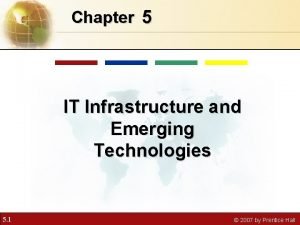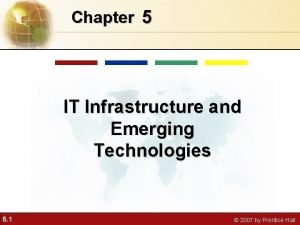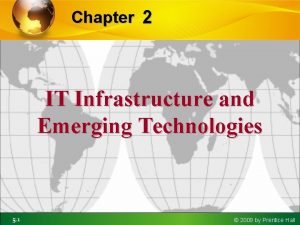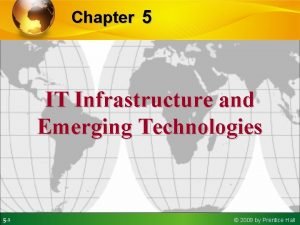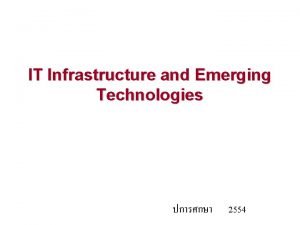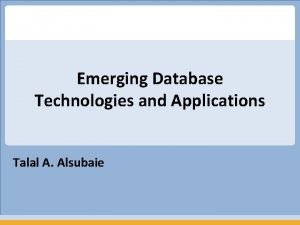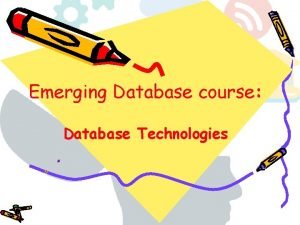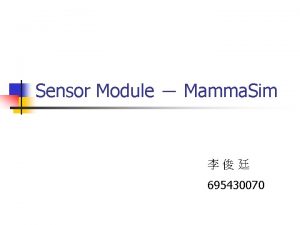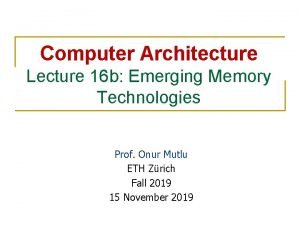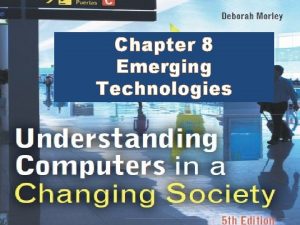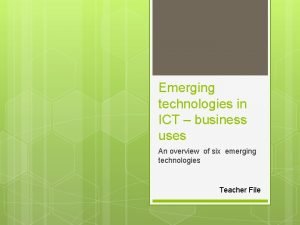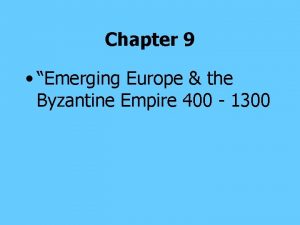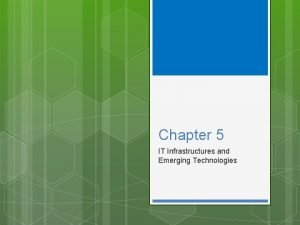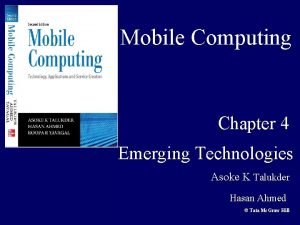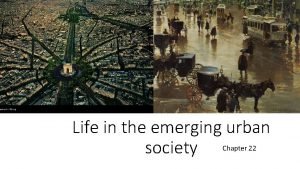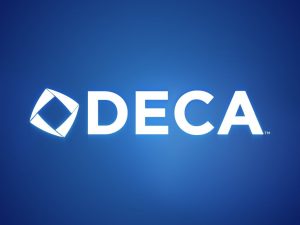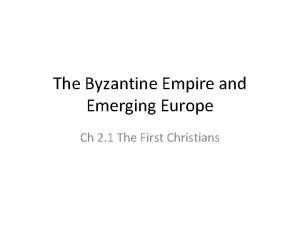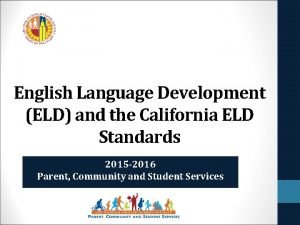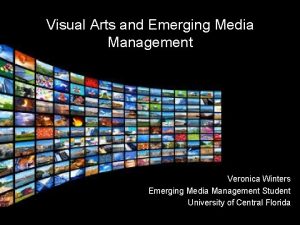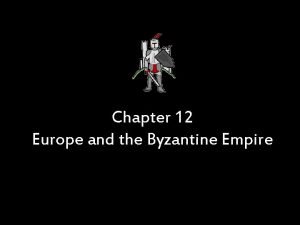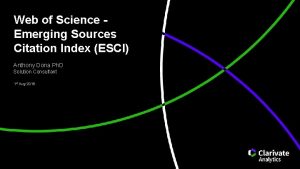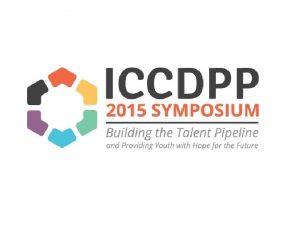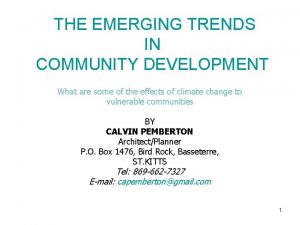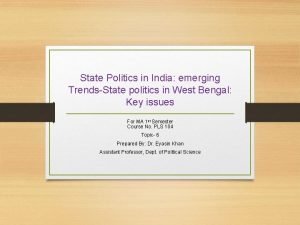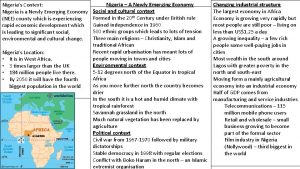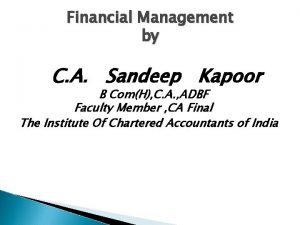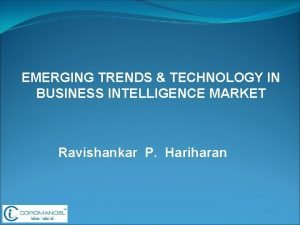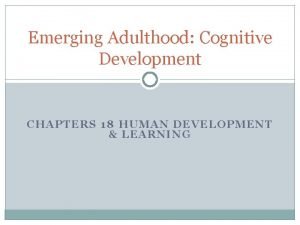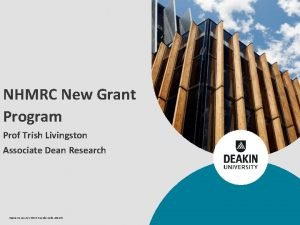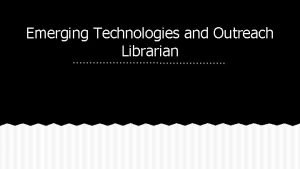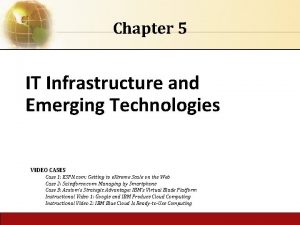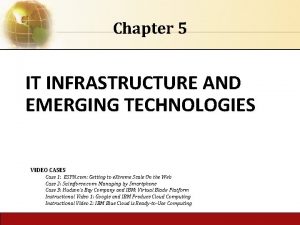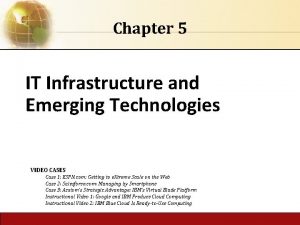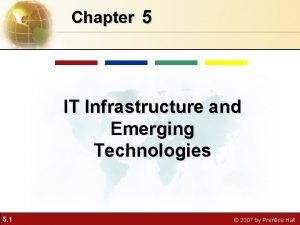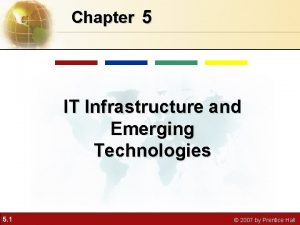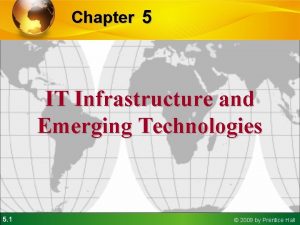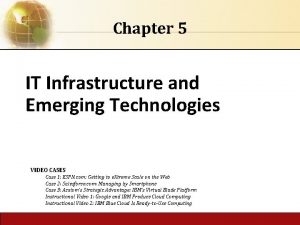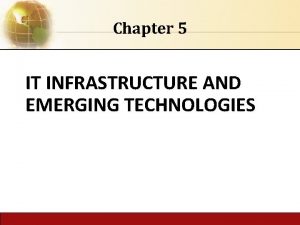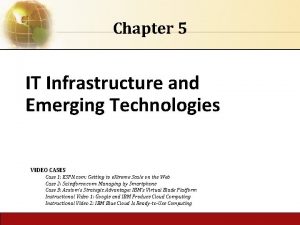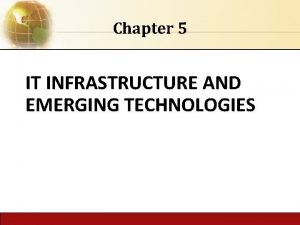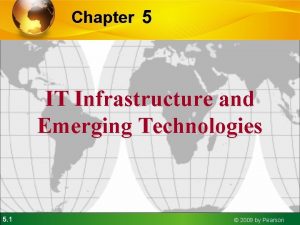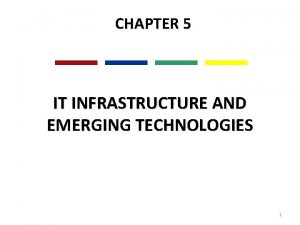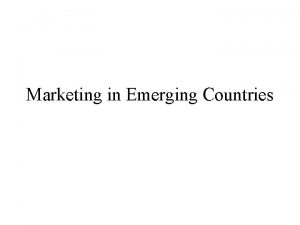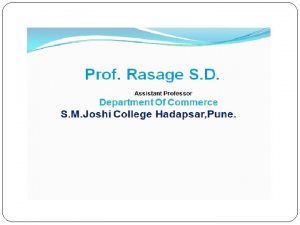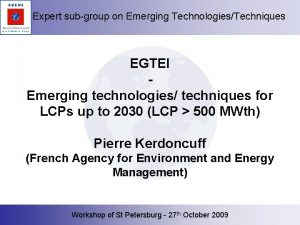Chapter 5 IT Infrastructure and Emerging Technologies 5



































- Slides: 35

Chapter 5 IT Infrastructure and Emerging Technologies 5. 1 © 2009 by Prentice Hall

Management Information Systems Chapter 5 IT Infrastructure and Emerging Technologies LEARNING OBJECTIVES • Define IT infrastructure and describe its components. • Identify and describe the stages and technology drivers of IT infrastructure evolution. • Assess contemporary computer hardware platform trends. • Assess contemporary software platform trends. • Evaluate the challenges of managing IT infrastructure and management solutions. 5. 2 © 2009 by Prentice Hall

Management Information Systems Chapter 5 IT Infrastructure and Emerging Technologies Cars. com’s IT Infrastructure Drives Rapid Business Growth • Problem: Aggressive growth plans hampered by outdated technology. • Solutions: Replaced entire IT infrastructure to allow the company to keep pace with its quick expansion. • IBM’s Web. Sphere application server and Rational software led to reduced costs and increased productivity. • Demonstrates IT’s role in fostering the growth of a business. • Illustrates IT infrastructure’s importance to a developing company. 5. 3 © 2009 by Prentice Hall

Management Information Systems Chapter 5 IT Infrastructure and Emerging Technologies IT Infrastructure • Defining IT infrastructure: • Set of physical devices and software required to operate enterprise • “Service platform” perspective more accurate view of value of investments>> • Set of firmwide services including: • • • 5. 4 Computing platforms providing computing services Telecommunications services Data management services Application software services Physical facilities management services IT management, standards, education, research and development services © 2009 by Prentice Hall

Management Information Systems Chapter 5 IT Infrastructure and Emerging Technologies IT Infrastructure Connection Between the Firm, IT Infrastructure, and Business Capabilities The services a firm is capable of providing to its customers, suppliers, and employees are a direct function of its IT infrastructure. Ideally, this infrastructure should support the firm’s business and information systems strategy. New information technologies have a powerful impact on business and IT strategies, as well as the services that can be provided to customers. Figure 5 -1 5. 5 © 2009 by Prentice Hall

Management Information Systems Chapter 5 IT Infrastructure and Emerging Technologies IT Infrastructure • Evolution of IT infrastructure • General-purpose mainframe and minicomputer era: 1959 to present • 1958 IBM first mainframes introduced, eventually used to support thousands of online remote terminals • 1965 less expensive DEC minicomputers introduced, allowing decentralized computing • Personal computer era: 1981 to present • 1981 Introduction of IBM PC • Proliferation in 80 s, 90 s resulted in growth of personal software • Client/server era: 1983 to present • Desktop clients networked to servers, with processing work split between clients and servers • Network may be two-tiered or multitiered (N-tiered) • Various types of servers (network, application, Web) 5. 6 © 2009 by Prentice Hall

Management Information Systems Chapter 5 IT Infrastructure and Emerging Technologies IT Infrastructure Eras in IT Infrastructure Evolution Illustrated here are the typical computing configurations characterizing each of the five eras of IT infrastructure evolution. 5. 7 Figure 5 -2 A © 2009 by Prentice Hall

Management Information Systems Chapter 5 IT Infrastructure and Emerging Technologies IT Infrastructure A Multitiered Client/Server Network (N-Tier) In a multitiered client/server network, client requests for service are handled by different levels of servers. Figure 5 -3 5. 8 © 2009 by Prentice Hall

Management Information Systems Chapter 5 IT Infrastructure and Emerging Technologies IT Infrastructure • Evolution of IT infrastructure (cont. ) • Enterprise Internet computing era: 1992 to present • Move toward integrating disparate networks, applications using Internet standards and enterprise applications • Cloud Computing: 2000 to present • Refers to a model of computing where firms and individuals obtain computing power and software applications over the Internet • Fastest growing form of computing 5. 9 © 2009 by Prentice Hall

Management Information Systems Chapter 5 IT Infrastructure and Emerging Technologies IT Infrastructure Eras in IT Infrastructure Evolution (cont. ) Figure 5 -2 B 5. 10 © 2009 by Prentice Hall

Management Information Systems Chapter 5 IT Infrastructure and Emerging Technologies IT Infrastructure • Technology drivers of infrastructure evolution (cont. ) • Standards and network effects • Technology standards: • Specifications that establish the compatibility of products and the ability to communicate in a network • Unleash powerful economies of scale and result in price declines as manufacturers focus on the products built to a single standard 5. 11 © 2009 by Prentice Hall

Management Information Systems Chapter 5 IT Infrastructure and Emerging Technologies Infrastructure Components • IT Infrastructure has 7 main components • • 5. 12 Computer hardware platforms Operating system platforms Enterprise software applications Data management and storage Networking/telecommunications platforms Internet platforms Consulting system integration services © 2009 by Prentice Hall

Management Information Systems Chapter 5 IT Infrastructure and Emerging Technologies Infrastructure Components The IT Infrastructure Ecosystem There are seven major components that must be coordinated to provide the firm with a coherent IT infrastructure. Listed here are major technologies and suppliers for each component. 5. 13 © 2009 by Prentice Hall

Management Information Systems Chapter 5 IT Infrastructure and Emerging Technologies Infrastructure Components • Computer hardware platforms • Client machines • Desktop PCs, mobile computing devices – PDAs, laptops • Servers • Blade servers: ultrathin computers stored in racks • Mainframes: • IBM mainframe equivalent to thousands of blade servers • Top chip producers: AMD, Intel, IBM • Top firms: IBM, HP, Dell, Sun Microsystems 5. 14 © 2009 by Prentice Hall

Management Information Systems Chapter 5 IT Infrastructure and Emerging Technologies Infrastructure Components • Operating system platforms • Operating systems • Client level: 95% run Microsoft Windows (XP, 2000, CE, etc. ) • Server level: 85% run Unix or Linux • Enterprise software applications • Enterprise application providers: SAP and Oracle • Middleware providers: BEA 5. 15 © 2009 by Prentice Hall

Management Information Systems Chapter 5 IT Infrastructure and Emerging Technologies Infrastructure Components • Data management and storage • Database software: IBM (DB 2), Oracle, Microsoft (SQL Server), Sybase (Adaptive Server Enterprise), My. SQL • Physical data storage: EMC Corp (large-scale systems), Seagate, Maxtor, Western Digital • Storage area networks: connect multiple storage devices on dedicated network 5. 16 © 2009 by Prentice Hall

Management Information Systems Chapter 5 IT Infrastructure and Emerging Technologies Infrastructure Components • Networking/telecommunications platforms • Telecommunication services • Telecommunications, cable, telephone company charges for voice lines and Internet access • AT&T, Verizon • Network operating systems: • Windows Server, Novell, Linux, Unix • Network hardware providers: Cisco, Lucent, Nortel, Juniper Networks 5. 17 © 2009 by Prentice Hall

Management Information Systems Chapter 5 IT Infrastructure and Emerging Technologies Infrastructure Components • Internet platforms • Hardware, software, management services to support company Web sites, (including Web hosting services) intranets, extranets • Internet hardware server market: Dell, HP/Compaq, IBM • Web development tools/suites: Microsoft (Front. Page, . NET) IBM (Web. Sphere) Sun (Java), independent software developers: Macromedia/Adobe, Real. Media 5. 18 © 2009 by Prentice Hall

Management Information Systems Chapter 5 IT Infrastructure and Emerging Technologies Infrastructure Components • Consulting and system integration services • Even large firms do not have resources for full range of support for new, complex infrastructure • Software integration: ensuring new infrastructure works with legacy systems • Legacy systems: older TPS created for mainframes that would be too costly to replace or redesign • Accenture, IBM Global Services, EDS, Infosys, Wipro 5. 19 © 2009 by Prentice Hall

Management Information Systems Chapter 5 IT Infrastructure and Emerging Technologies Contemporary Hardware Platform Trends • While cost of computing is lower, infrastructure costs have expanded • More computing, more sophisticated computing, increased consumer expectations, need for security • The emerging mobile digital platform • Cell phones, smartphones (Black. Berry, i. Phone) have assumed data transmission, Web surfing, e-mail and IM duties • Netbooks: small, low-cost lightweight notebooks optimized for wireless communication and core computing tasks 5. 20 © 2009 by Prentice Hall

Management Information Systems Chapter 5 IT Infrastructure and Emerging Technologies Contemporary Hardware Platform Trends • Grid computing • Connects geographically remote computers into a single network to combine processing power and create virtual supercomputer • Provides cost savings, speed, agility • Cloud computing (utility computing) • Data permanently stored in remote servers, accessed and updated over the Internet by users • Organizations using cloud computing need only pay for the computing power they actually use (on-demand or utility computing) 5. 21 © 2009 by Prentice Hall

Management Information Systems Chapter 5 IT Infrastructure and Emerging Technologies Contemporary Hardware Platform Trends • Autonomic computing • Industry-wide effort to develop systems that can configure, optimize themselves, heal themselves when broken, and protect themselves from outside intruders • Similar to self-updating antivirus software; Apple and Microsoft both use automatic updates • Virtualization and multicore processors • Virtualization: presents computing resources so that they can be accessed in ways that are not restricted by configuration • Allows multiple operating systems to run on one machine; increases server utilization rates from 10 -15 to 70 percent of capacity • Multicore processors: reduced power requirements, enhanced performance 5. 22 © 2009 by Prentice Hall

Management Information Systems Chapter 5 IT Infrastructure and Emerging Technologies Contemporary Software Platform Trends • Linux and open-source software • Open-source software: Produced by community of programmers, free and modifiable by user • Linux: Open-source software OS • Java • Object-oriented programming language (Sun Microsystems) • Operating system, processor-independent (Java Virtual Machine) • Leading programming environment for Web • Applets, E-commerce applications • Ajax • Asynchronous Java. Script and XML • Allows client and server to exchange small pieces of data without requiring the page to be reloaded 5. 23 © 2009 by Prentice Hall

Management Information Systems Chapter 5 IT Infrastructure and Emerging Technologies Software Platform Trends and Emerging Technologies • Web Services • Software components that exchange information using Web standards and languages • XML: Extensible Markup Language • More powerful and flexible than HTML • Tagging allows computers to process data automatically • SOAP: Simple Object Access Protocol • Rules for structuring messages enabling applications to pass data and instructions • WSDL: Web Services Description Language • Framework for describing Web service and capabilities • UDDI: Universal Description, Discovery, and Integration • Directory for locating Web services 5. 24 © 2009 by Prentice Hall

Management Information Systems Chapter 5 IT Infrastructure and Emerging Technologies Contemporary Software Platform Trends • SOA: Service-oriented architecture • Set of self-contained services that communicate with each other to create a working software application • Software developers reuse these services in other combinations to assemble other applications as needed • Example: an “invoice service” to serve whole firm for calculating and sending printed invoices • Dollar Rent A Car • Uses Web services to link online booking system with Southwest Airlines’ Web site 5. 25 © 2009 by Prentice Hall

Management Information Systems Chapter 5 IT Infrastructure and Emerging Technologies Contemporary Software Platform Trends How Dollar Rent a Car Uses Web Services Dollar Rent A Car uses Web services to provide a standard intermediate layer of software to “talk” to other companies’ information systems. Dollar Rent A Car can use this set of Web services to link to other companies’ information systems without having to build a separate link to each firm’s systems. 5. 26 Figure 5 -11 © 2009 by Prentice Hall

Management Information Systems Chapter 5 IT Infrastructure and Emerging Technologies Contemporary Software Platform Trends • Mashups and widgets • Mashups: Combinations of two or more online applications, such as combining mapping software (Google Maps) with local content • Widgets: small programs that can be added to Web pages or placed on the desktop to additional functionality • Software outsourcing • Three sources: external commercial vendor, online service providers, offshore firms • Software packages: prewitten set of software available commercially • Software as a service (Saa. S): software delivered over the Internet • Offshore outsourcing: usually governed by service level agreement 5. 27 © 2009 by Prentice Hall

Management Information Systems Chapter 5 IT Infrastructure and Emerging Technologies Contemporary Software Platform Trends The Changing Sources of Software U. S. firms currently spend about $250 billion each year on software. In 2008, about 40 percent of that software will originate outside the firm, either from enterprise software vendors selling firmwide applications or individual application service providers selling software modules. 5. 28 Figure 5 -12 © 2009 by Prentice Hall

Management Information Systems Chapter 5 IT Infrastructure and Emerging Technologies Contemporary Software Platform Trends Salesforce. com: Software-as-a-Service Goes Mainstream • Read the Interactive Session: Organizations, and then discuss the following questions: • What are the advantages and disadvantages of the softwareas-a-service model? • What are some of the challenges facing Salesforce as it continues its growth? How well will it be able to meet those challenges? • What kinds of businesses could benefit from switching to Salesforce and why? • What factors would you take into account in deciding whether to use Salesforce. com for your business? 5. 29 © 2009 by Prentice Hall

Management Information Systems Chapter 5 IT Infrastructure and Emerging Technologies Management Issues • Dealing with platform and infrastructure change • As firms shrink or grow, IT needs to be flexible and scalable • How does firm remain flexible and still make long term investments? • Scalability: Ability to expand to serve larger number of users • Firms using mobile computing and cloud computing require new policies and procedures for managing these new platforms • Contractual agreements with firms running clouds and distributing software required 5. 30 © 2009 by Prentice Hall

Management Information Systems Chapter 5 IT Infrastructure and Emerging Technologies Management Issues • Total Cost of Ownership of Technology Assets • TCO model: Used to analyze direct and indirect costs of systems • Hardware, software account for only about 20% of TCO • Other costs include: Installation, training, support, maintenance, infrastructure, downtime, space and energy • TCO can be reduced through greater centralization and standardization of hardware and software resources 5. 31 © 2009 by Prentice Hall

Management Information Systems Chapter 5 IT Infrastructure and Emerging Technologies Management Issues • Management and governance – Who controls IT infrastructure – Centralized/decentralized – How are costs allocated between divisions, departments? 5. 32 © 2009 by Prentice Hall

Management Information Systems Chapter 5 IT Infrastructure and Emerging Technologies Management Issues • Making wise infrastructure investments • Amount to spend on IT is complex question • Rent vs. buy, outsourcing • Competitive forces model for IT infrastructure investment • • • 5. 33 Market demand for firm’s services Firm’s business strategy Firm’s IT strategy, infrastructure, and cost Information technology assessment Competitor firm services Competitor firm IT infrastructure investments © 2009 by Prentice Hall

Management Information Systems Chapter 5 IT Infrastructure and Emerging Technologies Management Issues Competitive Forces Model for IT Infrastructure There are six factors you can use to answer the question, “How much should our firm spend on IT infrastructure? ” Figure 5 -13 5. 34 © 2009 by Prentice Hall

Group based Homework • Consider a small business that you are familiar with (Castello, Abu shanab…etc) • Because of the need to reduce costs, and also sell more people (website), this small business needs your group help to establish an IT infrastructure. • Explain to the owner what are the components of IT infrastructure? Which of these your group will use? And explain how each component work for the owner’s interest? • You may use the information in this chapter, and also the internet to provide a cost estimation. 5. 35 © 2009 by Prentice Hall
 Chapter 5 it infrastructure and emerging technologies
Chapter 5 it infrastructure and emerging technologies Computer hardware platforms in it infrastructure
Computer hardware platforms in it infrastructure Chapter 5 it infrastructure and emerging technologies
Chapter 5 it infrastructure and emerging technologies It infrastructure and emerging technologies
It infrastructure and emerging technologies It infrastructure and emerging technologies
It infrastructure and emerging technologies Emerging database technologies
Emerging database technologies Emerging database
Emerging database Emerging technologies introduction
Emerging technologies introduction Memory technology in computer architecture
Memory technology in computer architecture 8 emerging technologies
8 emerging technologies Emerging technologies in ict
Emerging technologies in ict The byzantine empire and emerging europe
The byzantine empire and emerging europe Mainframe and minicomputer era
Mainframe and minicomputer era Emerging technology chapter 4
Emerging technology chapter 4 Chapter 22 life in the emerging urban society
Chapter 22 life in the emerging urban society Deca prepares emerging leaders and entrepreneurs
Deca prepares emerging leaders and entrepreneurs Leo iii outlawed crucifixes as idolatry.
Leo iii outlawed crucifixes as idolatry. Eld emerging expanding bridging
Eld emerging expanding bridging Jeffrey arnett emerging adulthood theory
Jeffrey arnett emerging adulthood theory Emerging media definition
Emerging media definition The byzantine empire and emerging europe
The byzantine empire and emerging europe Esci clarivate
Esci clarivate Emerging technology synthesis
Emerging technology synthesis Trends in community development
Trends in community development Explain emerging patterns of state politics in india
Explain emerging patterns of state politics in india Emerging adulthood psychosocial development
Emerging adulthood psychosocial development Emerging proficient extending
Emerging proficient extending Is nigeria a newly emerging economy
Is nigeria a newly emerging economy Levinson seasons of life theory
Levinson seasons of life theory Emerging role of financial manager in india
Emerging role of financial manager in india Emerging trends in business intelligence
Emerging trends in business intelligence Emerging issues in industrial relations
Emerging issues in industrial relations Postformal thought
Postformal thought Discuss the art of emerging europe.
Discuss the art of emerging europe. Jeffrey arnett emerging adulthood theory
Jeffrey arnett emerging adulthood theory Trish livingston deakin
Trish livingston deakin
